If you’re looking for the best things to do in Ushuaia, Argentina, you’ve come to the right place! This ultimate Ushuaia travel guide has everything you need to know.
Ushuaia is one of those destinations that feels like a major accomplishment as a traveller. After all, it takes a lot of effort and planning to reach the southernmost city in the world, so when you get there, you want to make sure you’re making the most of your trip!
During my very first trip to Ushuaia, I spent an action-packed 2 weeks there. I visited all the main attractions as well as some lesser-known sites, I did a lot of hiking, went on day tours, stayed at a few different accommodations and restaurant-hopped my way across the city.
As a result, I feel like I have a really good understanding of everything there is to do in Ushuaia!
Today, I want to share everything I know about this destination to help you have the most amazing time there. In this massive Ushuaia travel guide, I’m going to tell you the best things to do in Ushuaia, how to get there, fun day trips and hikes you can go on, where to stay in the city, and the best time to visit.
It’s a lot of information, but as it turns out, there’s a lot to do at the End of the World. Now let’s dive in!
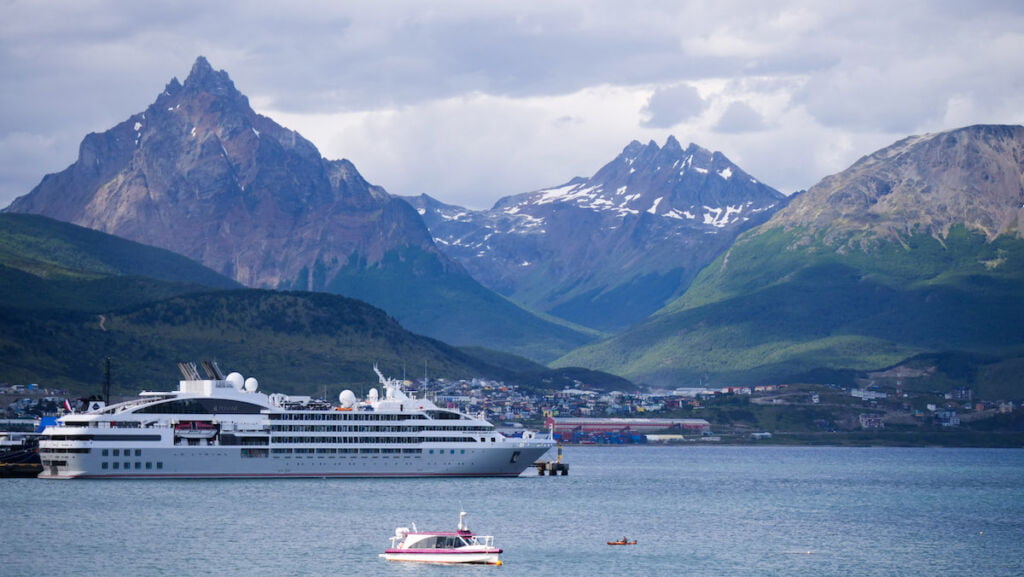
How to get to Ushuaia
Getting to Ushuaia can be quite an adventure, depending on the mode of transportation you choose.
The quickest and most straightforward option is to fly into Aeropuerto Internacional Malvinas Argentinas. There are multiple daily flights from Buenos Aires, though you can also get flights from some other major Argentine cities during high season.
The flight from Buenos Aires to Ushuaia is 3 hours and 40 minutes.
The next option is bus travel, which makes more sense if you’re already travelling in southern Patagonia (around El Calafate or El Chaltén). The bus journey does involve going through Chile (a good excuse to stop over in Torres del Paine National Park!) and it also includes a ferry crossing.
You can read our detailed guide on how to get to Ushuaia here.
Things to do in Ushuaia, Argentina
First up, let’s dive into the top attractions in Ushuaia you won’t want to miss during your visit!
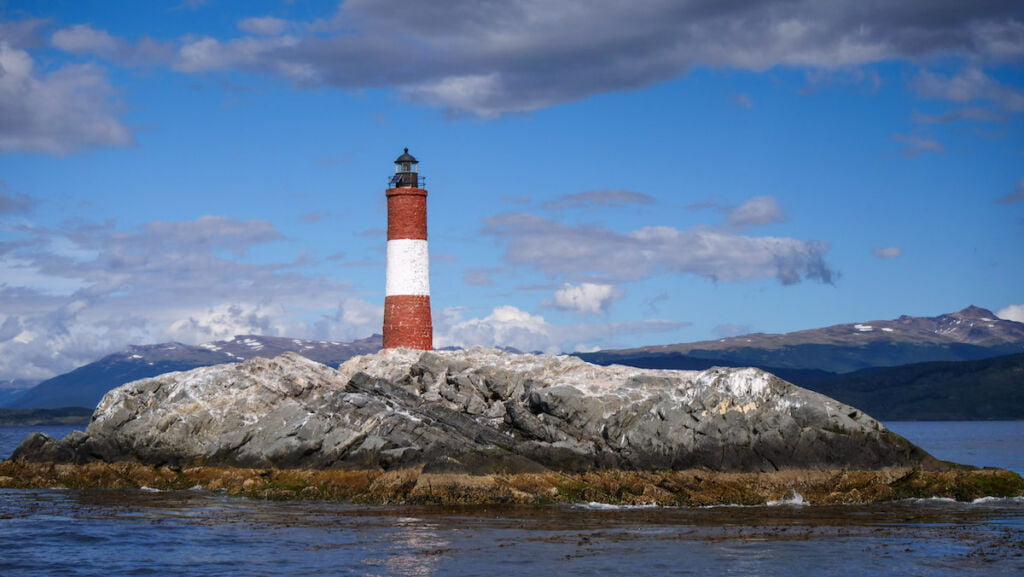
Cruise the Beagle Channel
One of the top things to do in Ushuaia is to go on a boat cruise of the Beagle Channel and enjoy the wildlife at the bottom tip of South America!
The Beagle Channel is the strait that separates Isla Grande, the main island of Tierra del Fuego, from various smaller islands. Plus, the channel also acts as a border between Chile and Argentina. This is one of three navigable bodies of water that act as a passage from the Atlantic Ocean to the Pacific Ocean at the bottom of South America; the two others are the Straits of Magellan to the north and the open-ocean Drake Passage to the south.
There are numerous Beagle Channel tours to choose from, ranging from catamarans to sailboats, but all afford the opportunity to view seabirds, sea lions and penguins! One tour even lets you walk amongst penguins on Martillo Island, though keep in mind this one needs to be booked in advance as only a very small number of visitors are allowed on Isla Martillo each day.
You also get to cruise past the famous Les Eclaireurs Lighthouse, an iconic red and white-striped lighthouse that stands 11 metres high on a rocky outcrop some 5 nautical miles east of Ushuaia.
It is locally known as ‘the Lighthouse at the End of the World’, but that title officially belongs to the San Juan de Salvamento lighthouse, which was made famous by Jules Verne in the novel The Lighthouse at the End of the World, and is located on Isla de los Estados much further east.
Unfortunately, it is not possible to go inside Les Eclaireurs Lighthouse, however, a Beagle Channel tour is a great opportunity to see it up close, and the captain does linger in the area so tourists can take their photos.
Tip: Make sure you bring your passport on the boat cruise because staff will come around and offer you a stamp of the Beagle Channel.
Pose at the Fin del Mundo sign
Every traveller in Ushuaia has to pose next to the Fin del Mundo sign, literally the ‘End of the World’ sign. This is kind of like a right of passage to prove you made it to the southernmost city in the world. The sign is on the waterfront right next to the tourist pier where all the Beagle Channel cruises depart from.
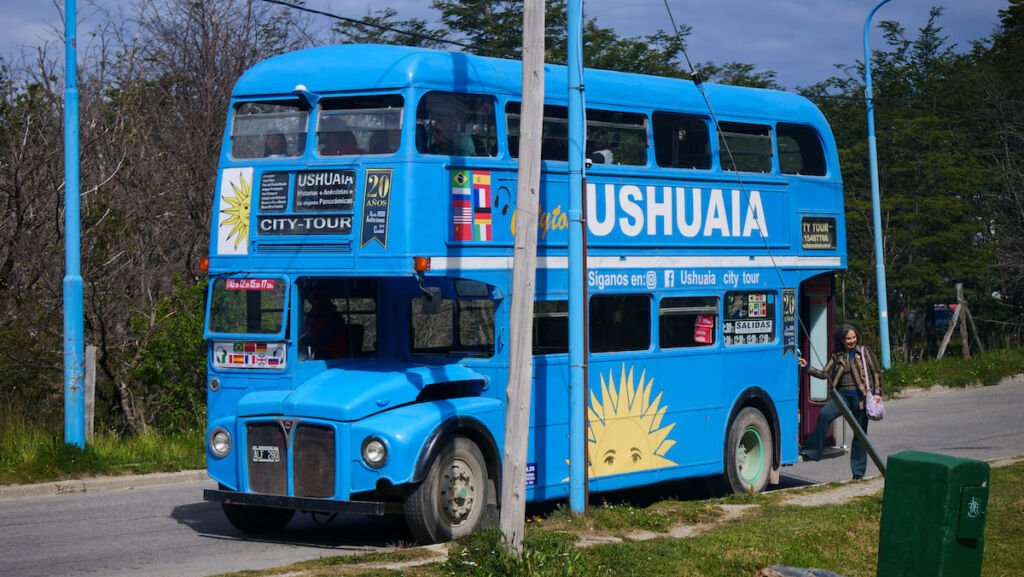
Tour Ushuaia by Double-Decker Bus
One fun way to experience Ushuaia is by going on a double-decker bus tour of the city. This is a great activity to do at the very start of your trip so you can get an idea of the lay of the land.
The bus tour is 1 hour and 10 minutes in length and it’s an opportunity to enjoy views of the Beagle Channel, soak in the beauty of the surrounding mountain peaks, and cruise the city streets.
This is done as an audio tour where guests receive a headset and can learn about Ushuaia’s history in 8 different languages.
This hour-long Ushuaia double-decker bus tour provides a good overview of the city beyond the top tourist sites.
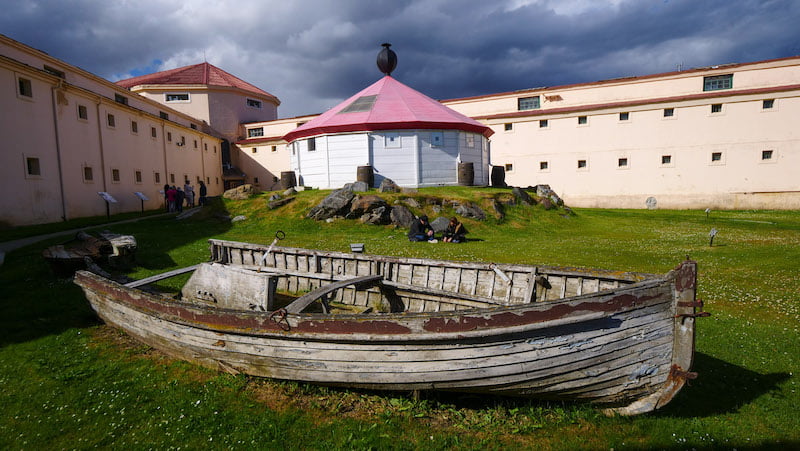
Visit the Old Ushuaia Prison
One of Ushuaia’s main attractions is the Prison at the End of the World, also known as the Ushuaia Prison. This is because the city of Ushuaia was founded as a penal colony, with the first prisoners arriving in 1884.
The prison was in operation between 1902 and 1947 and was known for its harsh conditions, meaning it was damp, humid and cold. Not the kind of place you’d want to end up.
Today, the prison has been turned into a tourist site, and it houses multiple museums. The prison’s five wings converge in a central hall and each wing holds a different museum.
These include the Prison Museum, which focuses on the stories of the prisoners; the Maritime Museum, where you can see scale models of vessels that would have sailed the waters in this part of the world; the Antarctic Museum, which highlights the age of exploration and scientific expeditions; the Art Museum, showcasing a collection of maritime-inspired art; and the Art Gallery, where local artists can showcase and sell their artwork.
There’s a lot to see here, so give yourself at least a couple of hours to visit the various wings and exhibits.

Hike Tierra del Fuego National Park
No trip to Ushuaia would be complete without visiting Tierra del Fuego National Park, the southernmost national park in Argentina.
The park is located just 11 kilometres west of Ushuaia, so it’s fairly easy to get there either by shuttle or joining a guided tour.
The park is renowned for its hiking trails, which range from easy walks to more challenging treks, with the most famous being the Pampa Alta Trail and the Coastal Path.
You can also expect to see beavers in Tierra del Fuego National Park. These are not native to Argentina but they were introduced to the region in 1946 in an attempt by the Argentine government to generate a fur trade; that was an environmental disaster!
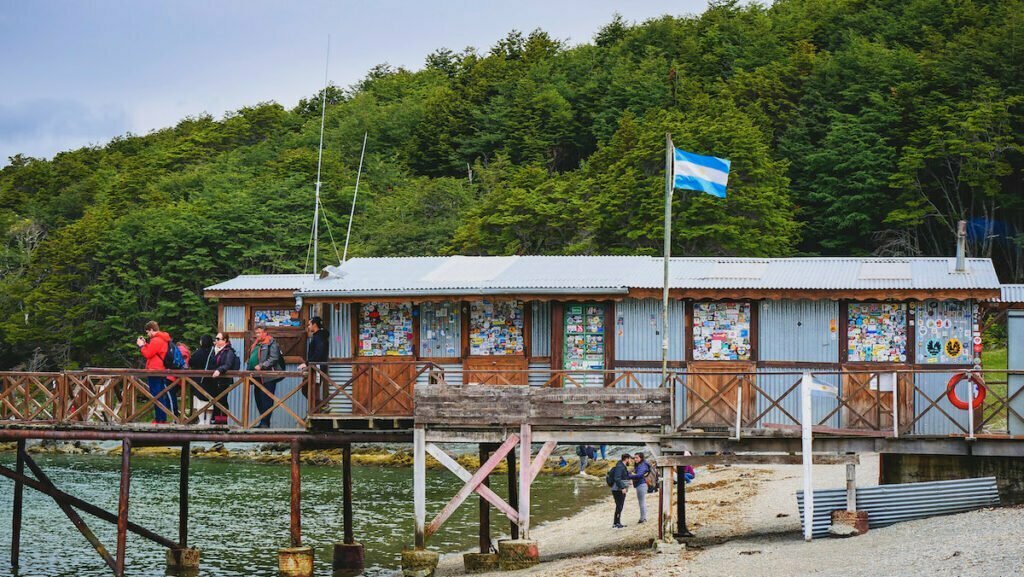
Send mail from the Southernmost Post Office
One place you cannot miss when you visit Tierra del Fuego National Park is the post office at the end of the world.
Made of corrugated metal and wood, this tiny post office sits atop a pier on the shores of the Beagle Channel, and it’s the last chance to send mail before reaching Antarctica.
The exterior is plastered with stickers from travellers who’ve reached this place from all corners of the world, and inside the walls are covered in postcards, maps, magnets and currencies from faraway lands.
Aside from sending mail, this is one of several places in Ushuaia where you can get your passport stamped, so don’t forget to bring your passport.
It does cost a few dollars ($2.50 USD when we were there), but it’s a full page with several stamps, and it’s a special souvenir from your time visiting the city at the end of the world.
In my experience, it can take about 3 weeks for international mail to reach its final destination, so be patient if you send mail.
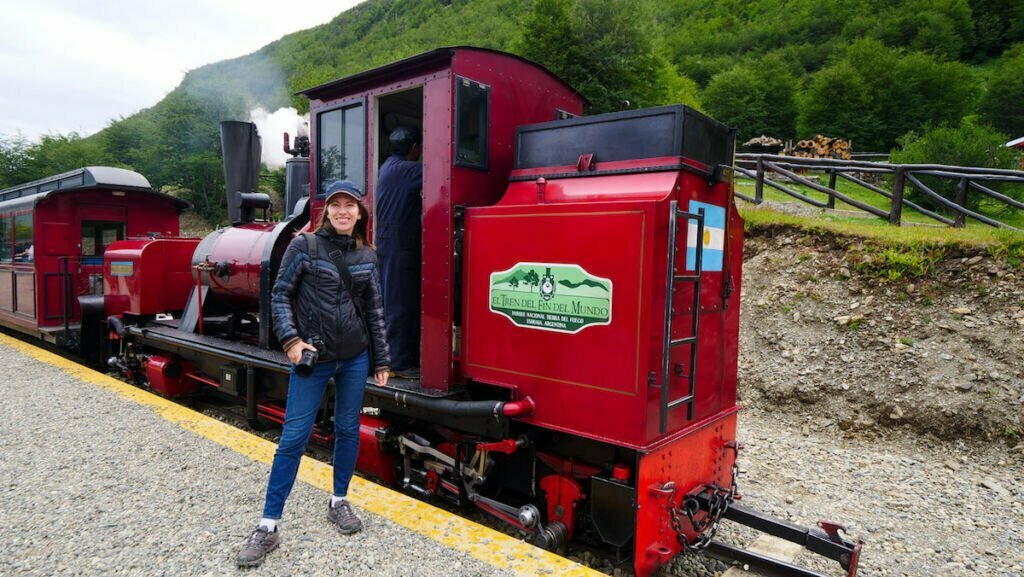
Ride the Train at the End of the World
One of the best things to do in Ushuaia for train enthusiasts is to ride the Southern Fuegian Railway, also known as the Train at the End of the World!
Once upon a time, this was known as the train of prisoners. As we mentioned earlier, Ushuaia started out as a penal colony and prisoners were put to work building their own prison. This meant transporting rock and timber from the nearby forests to the town, first using oxen-pulled wagons, and eventually, this narrow-gauge railway.
Today, the train has been developed into a heritage train, and it’s considered the southernmost functioning railway in the world.
The journey begins at the Train Station at the End of the World and then crosses the Cañadón del Toro (Bull’s Canyon) and the Pipo River over the Puente Quemado (Burnt Bridge).
The train then makes a stop at La Macarena Waterfall Station, where visitors can climb out to a viewpoint and see the waterfall.
The journey continues to the boundary with Tierra del Fuego National Park where you can witness peat bogs and the tree cemetery, a collection of stumps left from nearly half a century of cutting down forest to supply the town with firewood – a job that was done by the prisoners.
Lastly, the train reaches Tierra del Fuego National Park where visitors have the option of remaining in the park or completing the journey back.
This guided tour includes a ride aboard the End of the World Train and a visit to Tierra del Fuego National Park. It also includes transportation there and back.
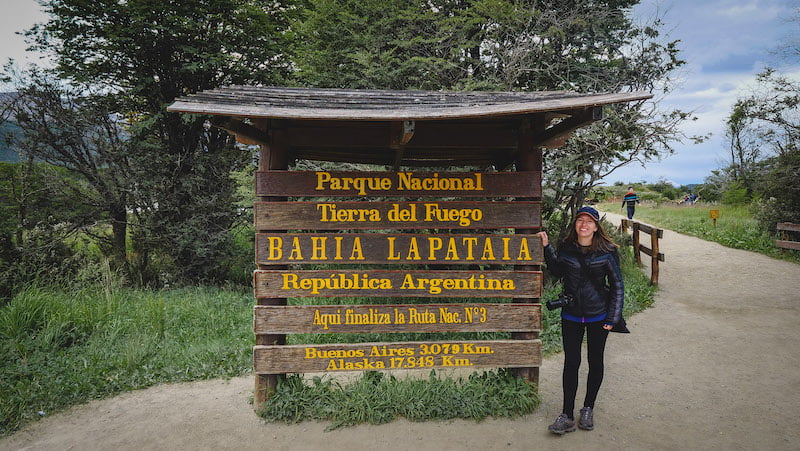
Reach the End of the Road in Lapataia Bay
I’ve included a lot of signs to pose next to in Ushuaia, and I’m about to share one more: Lapataia Bay.
So what’s the significance of Lapataia Bay? Well, this is officially where the road ends. It is the southernmost point you can drive in the Western Hemisphere, and there is a sign marking the end of National Route 3, which is the last leg of the Pan-American Highway.
From this point, you’d have to drive 17,848 kilometres to reach the opposite end of the road in Alaska. I think that’s worth a photo op!
Take a Helicopter tour over Ushuaia
One unforgettable way to experience Ushuaia is by taking a helicopter tour to soak in the views of the southernmost city in the world, perfectly framed by the Andes Mountains.
This activity may sound like a bit of a splurge, and it can be if you opt for a landing in the mountains followed by a champagne toast, however, you can also take a short scenic flight over the city and not break your budget.
HeliUshuaia is the local helicopter tour operator and offers three different flight options: a 7-minute flight over Ushuaia and the Beagle Channel, a 15-minute flight that goes as far as Laguna Esmeralda, or a 30-minute flight that takes you even further into the Andes Mountains with a landing and bubbly to celebrate.
Tip: Book your helicopter tour early on in your visit in case it case to be rescheduled due to weather.
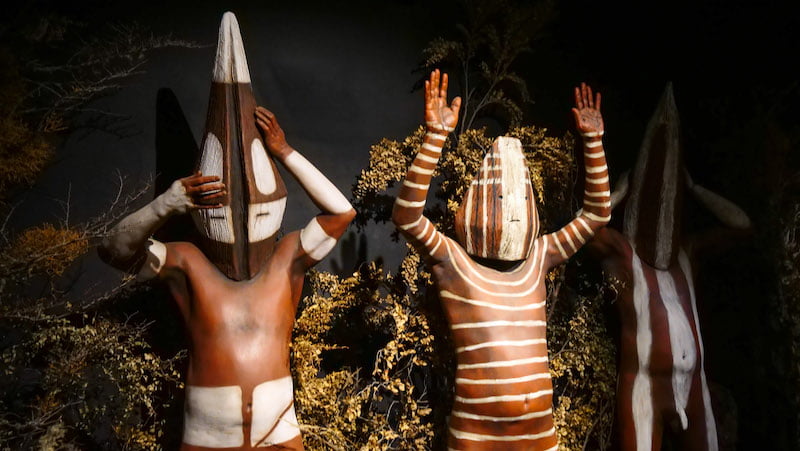
Visit Galeria Tematica de Historia Fueguina
Another unique museum we visited was the Galería Temática Historia Fueguina. This is a museum featuring dioramas and lifelike figures that showcase the history of the province of Tierra del Fuego.
The visit is done as a self-guided tour with an audio guide, so you can go at your own pace.
The tour starts out by sharing the history of the indigenous people who lived in this area, which included: the Yamanas, who were coastal hunter-gatherers and fishers, known for their canoe-building skills; the Shelknam, who were nomads, guanaco hunters, and renowned for their use of the bow and arrow; and the Haush, who are the least known of the three groups and lived in the southernmost part of the island which has a lot of peat bogs.
The tour then moves on to the early exploration and colonization of Tierra del Fuego. It also has sections focusing on the HMS Beagle, Ushuaia’s early beginnings as a penal colony, and Ernest Shackleton’s Endurance.
We found the museum to be very educational, and it’s especially worth the visit if you can take the time to listen to the audio guide.
Check out some lesser-known museums
If you get some bad weather days and are looking for some rainy day activities, consider visiting some smaller and lesser-known museums in town.
First, you have Museo del Fin del Mundo, or End of the World Museum, which is located inside the old Government House.
The museum is focused on a variety of topics, including local history and natural history, with exhibits on sailing, whaling, seabirds & more.
There’s also a small botanical garden right next to the museum, which can be really nice in the summertime when the flowers are in bloom.

Sample traditional Fuegian cuisine
If you’re a foodie, one of the best things to do in Ushuaia is to try Fuegian food, showcasing dishes native to Tierra del Fuego.
Given the proximity to the sea, seafood is a fundamental part of the Fuegian diet. This included fish such as sea bass, hake, and mackerel. Plus, shellfish like mussels, clams, and sea urchins. And we cannot forget King crab, which is locally known as centolla.
Patagonian lamb is another food staple of the region, given the number of estancias in the area. You’ll find lamb served at numerous parilla restaurants specializing in grilled meats.
As for desserts, you’ll notice lots of calafate berries on the menu. These are small berries that grow on bushes and they’re used in ice creams, cakes, smoothies, you name it!
You can check out our list of where to eat in Ushuaia for some restaurant recommendations.
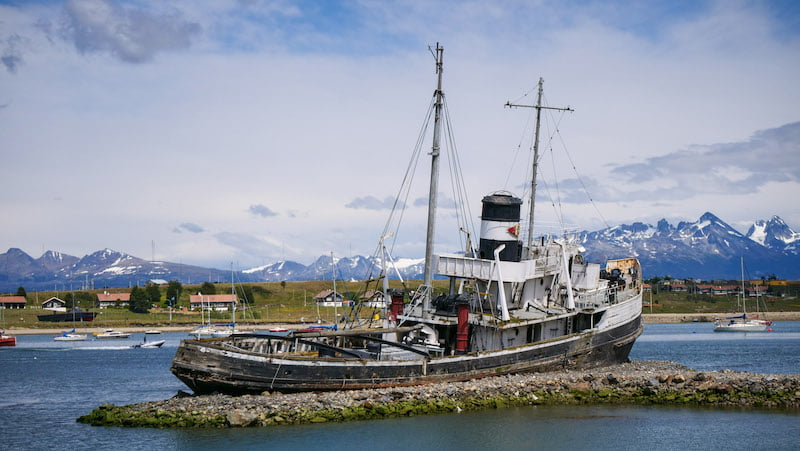
View the Saint Christopher shipwreck
There are quite a few landmarks you can visit while walking along the waterfront in Ushuaia, and one of the more famous vessels here is the San Cristóbal, or Saint Christopher, which sits on the shores of the Beagle Channel.
Once known as the HMS Justice, this was a Royal Navy ship classified as a rescue tug and it served at the Normandy landings during World War 2.
When the war ended, the ship was sold and renamed Saint Christopher, where it was chartered for salvage operations in Beagle Channel.
After suffering engine trouble and rudder damage, it was eventually beached and abandoned on the shores of Ushuaia.
Now Saint Christopher can be admired from shore, though no one is permitted aboard.
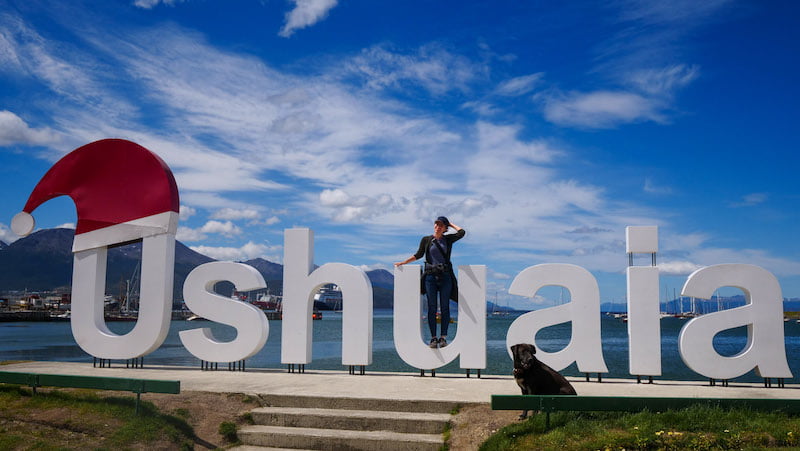
Pose at the Ushuaia city sign
So many signs and so many photo ops, but that’s Ushuaia for you. Another spot you cannot miss is the Ushuaia city sign located on the waterfront right across from Plaza Islas Malvinas.
This is the classic city sign you’ll encounter in numerous cities across Argentina. It does change up a little bit during the year, mainly during the Christmas holidays when the giant U sports a Santa Claus hat.
Typically, a line of tourists will form. You will take a photo for the person ahead of you and the next person in line will do the favour of taking your picture for you.
Hikes in Ushuaia
There are plenty of hiking opportunities in and around Ushuaia, both in Tierra del Fuego National Park and in the city outskirts. We’re going to highlight some of the best hikes in Ushuaia, ranging in length and level of difficulty.
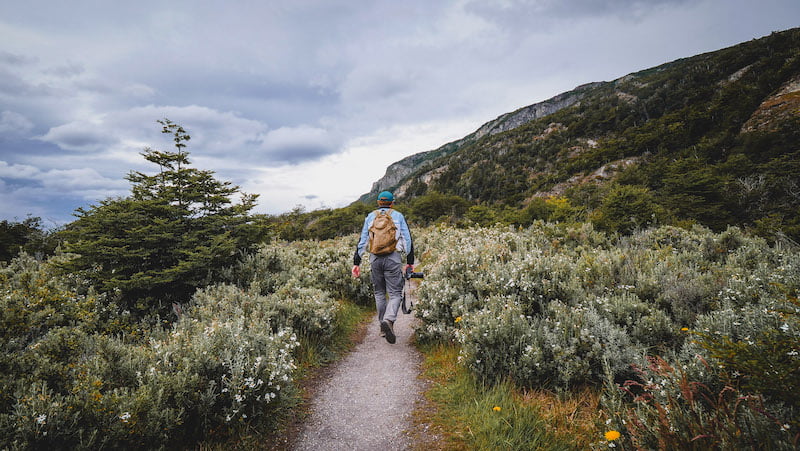
Senda Costera
The Senda Costera or Coastal Path is a hike known for its breathtaking coastal views. The trail is approximately 8 kilometres long and is considered a moderately easy hike. It typically takes around 3 to 4 hours to complete the hike, making it suitable for hikers of various skill levels.
Hikers can expect to see stunning vistas of the Beagle Channel, come across beautiful pebbly coves, and hike through Southern Fuegian forest.
This coastal trail runs from Zaratiegui Bay to Alakush, so you can get dropped off at either starting point and hike in either direction. I would recommend hiking from Zaratiegui Bay to Alakush since there’s a cafe at the end where you can enjoy a hot meal at the end of the trek. That’s how we did this particular hike.
The trail is flat most of the way, though you do gain some elevation as you approach Alakush.
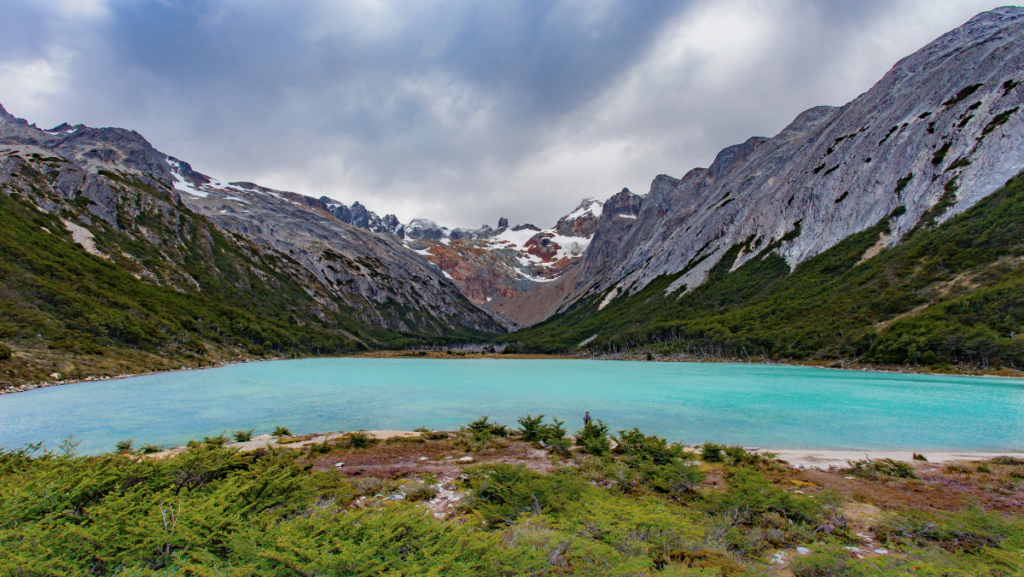
Laguna Esmeralda
This is a popular day hike that leads to a lagoon with emerald waters surrounded by mountains. The hike is 8.7-km out-and-back but the hiking time greatly varies depending on the time of year and the ground conditions.
During the summer, this hike can be done in 2.5-3 hours, but once the trail is covered in snow and ice, the same hike could take 4-5 hours.
The trail can get quite muddy as you need to cross a fairly large swamp, followed by a steep hike with rocks, but the reward is an impressive emerald lagoon at the end.
Trekking poles and crampons are recommended if you’re attempting this hike outside the summer months.
If you feel safer doing this with a guide, you can join a guided trek to Laguna Esmeralda.
Martial Glacier
The glacier atop the Martial Mountains is named after Captain Ferdinand Martial of the Cap Horn Scientific Mission, a French expedition that arrived in Tierra del Fuego in September 1882.
This hike is 6.3 km out-and-back and is considered a moderate hike. The only thing that tends to disappoint some visitors is that you won’t find an impressive glacier! Much of what you see is a moraine, the rocks and sediment carried down and deposited by a glacier that once existed.
You can start this hike from Refugio de Montaña Glaciar Martial. Right across, you’ll see La Cabaña de Té, a cute tea house where you can enjoy some sandwiches, cookies, pastries and a hot beverage either before or after your hike.
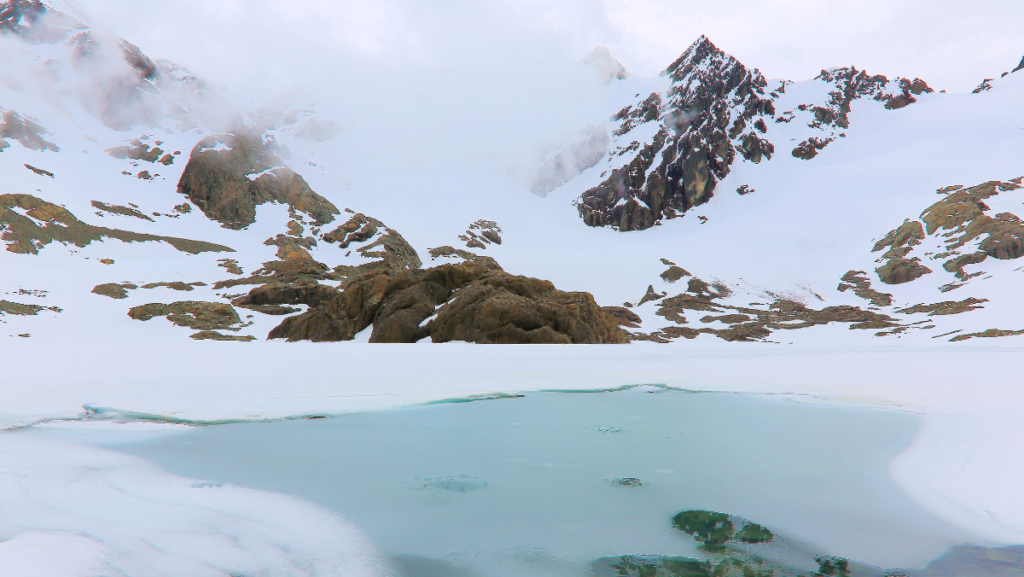
Vinciguerra Glacier and Laguna de los Témpanos
The Vinciguerra Glacier is one of the largest glaciers in Tierra del Fuego, situated in the Andes Mountains about 20 kilometres northwest of Ushuaia.
The trail to Vinciguerra Glacier is quite varied, going through dense forests, peat bogs, and stretches of rocky terrains.
It’s considered a moderately challenging hike that takes anywhere between 4 to 6 hours round trip, depending on the weather conditions and the group’s hiking pace.
At the base of the Vinciguerra Glacier, you’ll find Laguna de los Témpanos. This is a glacial lagoon with floating icebergs that break off from the glacier above.
While the Vinciguerra Glacier can be accessed year-round, the best hiking window is in the summertime from December to March when the weather is milder and the paths are less treacherous.
You can visit the Vinciguerra Glacier with a small group guided tour.
Laguna del Caminante
For a more challenging hike in Ushuaia, you have Laguna del Caminante. This is a 24 km point-to-point trail through Tierra del Fuego National Park that can take anywhere between 8 to 13 hours to complete, depending on the conditions and the time of year.
Some people opt to hike Laguna del Caminante as a 2-day trek, renting a tent and sleeping bag in town and then camping next to the lagoon.
If you’re not a very experienced hiker, you’ll want to book a guide for this hike. It’s fairly remote and you’re not likely to encounter other hikers along the way.
For more ideas of hikes you can do around Ushuaia, check out this list by All Trails.
Day trips from Ushuaia
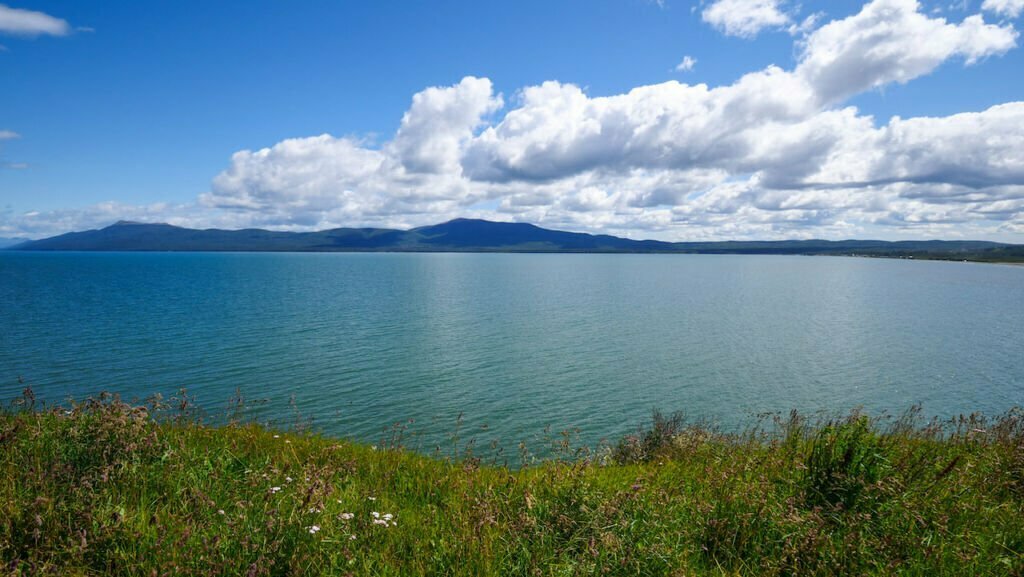
Tolhuin
One of the most popular side trips from Ushuaia is the lakeside town of Tolhuin. Located 1 hour and 10 minutes away from Ushuaia, this is a destination that can either be visited as a day trip, or if you want to linger in a quiet town, you can easily spend 2-3 days here.
The main attraction is Lago Fagnano, a lake of glacial origin that stretches across both Argentina and Chile. When the waters are calm, this is a nice place to go kayaking. There are also lakeside trails to explore in Laguna Negra Provincial Reserve.
Essentially, this is a place to completely disconnect, enjoy the remoteness of it all, and unwind after a few days in Ushuaia. You can get some ideas of things to do in Tolhuin here.
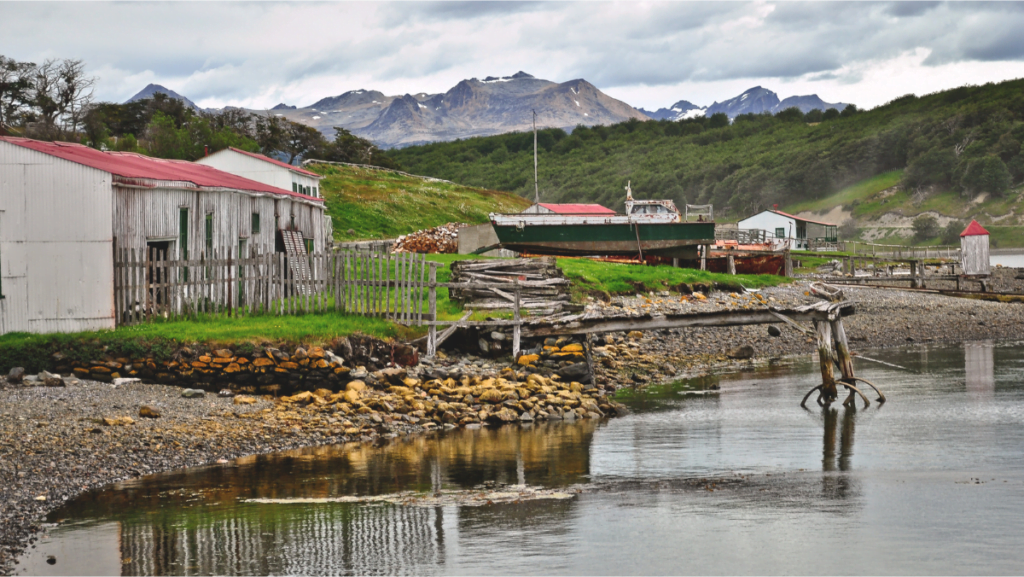
Estancia Harberton
Estancia Harberton is the most famous estancia in Tierra del Fuego province. It is located about 1 hour and 25 minutes east of Ushuaia, with most of the journey being on a gravel road.
The estancia dates back to 1886, when it was founded by Reverend Thomas Bridges, an English missionary who worked with the indigenous Yámana people and who was also the author of the dictionary of the Yámana language. The Argentine government granted him this land in appreciation of his services.
The estancia or ranch covers some 50,000 acres of predominantly sheep-grazing land, interspersed with patches of native forests, and it is bordered by the Beagle Channel.
Within the estancia grounds, you’ll also find the Acatushún Museum, which is focused on marine mammals and birds; it’s especially famous for its collection of marine mammal skeletons.
The best way to visit Estancia Haberton is by joining a guided tour, which includes transportation to and from the ranch.
Paso Garibaldi
The Garibaldi Pass is the only paved route across the Fuegian Andes and also the highest point on Argentina’s Ruta Nacional 3.
It’s a beautiful winding journey over the mountains with a breathtaking lookout along the way, where you can spot Lago Escondido, which translates to ‘hidden lake’.
You can rent a car and drive this route, however, for an even better experience, I would recommend doing the 4×4 overland tour that goes along the lake’s edge and through the forest, eventually reaching Lago Fagnano.
Because this is Argentina, you shouldn’t be too surprised that the tour concludes with a traditional Argentine BBQ featuring choripán, bife de chorizo, salad, Malbec wine, and cheese.
If you need more ideas, check out this list of 10 Ushuaia tours you won’t want to miss.

Where to stay in Ushuaia
Ushuaia offers a range of accommodations to suit different budgets and preferences ranging from luxury to mid-range to budget-friendly options. Here are some places to consider:
Arakur Ushuaia Resort & Spa
For those looking for a taste of luxury, you cannot go wrong with Arakur Ushuaia Resort & Spa. This is considered the best hotel in Ushuaia and because it’s perched on a mountain, it offers great views of the Beagle Channel and the city below. The indoor and outdoor infinity pool is one of the key selling points of this high-end property.
Alto Andino Hotel
Situated in downtown Ushuaia, this mid-range hotel is a great choice for travellers who want to be in the heart of it all and mainly get around on foot. They have single, double, triple and quadruple rooms as well as apartments for those who prefer a self-catered holiday. This hotel also offers a complimentary breakfast that is served in their rooftop Bar Lookout, which offers spectacular views of Ushuaia.
Hotel de Los Andes
Hotel de Los Andes is a budget-friendly option right in the centre of Ushuaia, only two blocks from the waterfront. Rooms are simple but bright, and they offer free high-speed internet in all rooms as well as common areas. Their on-site restaurant Bar D Pizzas serves up stone-baked pizzas and beer.
For more accommodation options, read our complete guide on where to stay in Ushuaia for all budgets. Keep in mind that Ushuaia is a popular tourist destination, so it’s a good idea to book your accommodations in advance, especially if you’re visiting during the peak summer season.
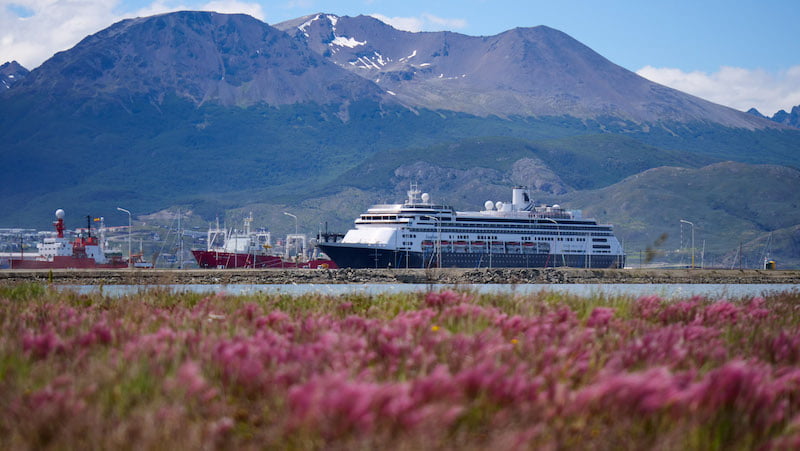
Antarctica Cruises from Ushuaia
There are two types of travellers in Ushuaia: those who are here to experience the city at the end of the world and those who have a cruise to catch because they’re going all the way to Antarctica! If you’re in the second category, you are one lucky traveller.
There are all sorts of cruises departing for Ushuaia, some which detour over to the Falkland Islands and South Georgia, and others that cruise the Antarctic Peninsula.
Here are 4 different Antarctica cruises to consider:
- Antarctica Classic (11 days)
- Antarctica Classic in Depth (13 days)
- Quest for the Antarctic Circle (14 days)
- Spirit of Shackleton (21 days)
You can find last-minute Antarctica cruises in Ushuaia. You’ll typically see these advertised in the windows of tour agencies or on posters on the street.
The prices are low, but the issue is that you may need to be ready to get on a cruise the next day, or you may have to wait around for a couple of weeks.
If you can, it’s better to book in advance and to book during a sale.

Best time to visit Ushuaia
Ushuaia is a destination that can be visited year-round, but the best time to visit depends on your personal interests and what you’re hoping to do during your tip. Here’s a breakdown of what each season in Ushuaia has to offer:
Summer in Ushuaia (December to February)
- This is the peak tourist season in Ushuaia.
- The weather is relatively mild with temperatures ranging from 41°F / 5°C to 59°F / 15°C.
- Days are long with plenty of daylight for outdoor activities.
- It’s the best time for hiking, wildlife watching, and boat tours to nearby islands.
- This is also the time of year when cruise ships depart for Antarctica (a very short window).
Fall in Ushuaia (March to May)
- Fall is a quieter time to visit Ushuaia, with fewer tourists.
- The weather begins to cool down and you can experience the beautiful fall foliage.
- Wildlife is still active, and it’s a good time for birdwatching.
- Prices for accommodations and tours are lower compared to the summer months.
Winter in Ushuaia (June to August)
- Winter in Ushuaia is cold and snowy.
- This is the best time for winter sports enthusiasts, as you can go skiing, snowboarding, snowshoeing and snowmobiling in the nearby mountains – Cerro Castor is the it destination for winter sports.
- The city itself has a cosy atmosphere during this time, with many indoor activities and restaurants to enjoy.
- Keep in mind that some attractions and tours may be limited during the winter season.
- Many of the hiking trails close during the winter months.
Spring in Ushuaia (September to November):
- Spring is a transitional season, with temperatures gradually warming up.
- This is a good time for hiking and enjoying the changing landscapes as plants and flowers begin to bloom.
- Wildlife becomes more active as well, making it a great time for nature enthusiasts.
- Similar to fall, spring is less crowded than the summer months.
Ultimately, the best time to visit Ushuaia depends on your interests and the activities you want to pursue. If you want to experience milder weather and long daylight hours for outdoor adventures, consider visiting during the summer. If you prefer a quieter and more budget-friendly trip, fall and spring can be excellent choices. And if you’re a winter sports enthusiast, the snowy months of June to August are ideal.
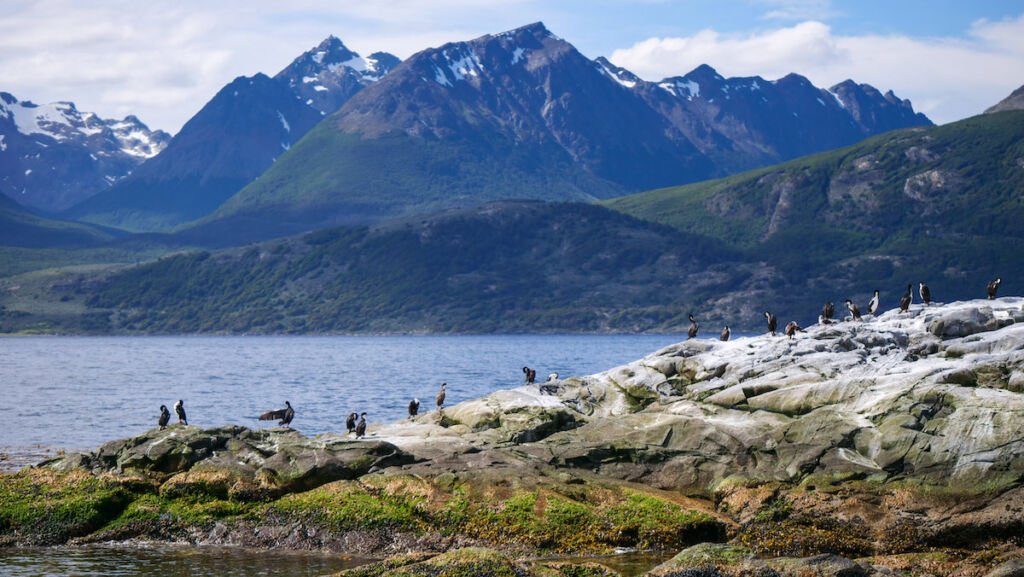
Travel tips for visiting Ushuaia
- Pack for winter, no matter what time of year you’re visiting. This may sound a bit extreme, but you are travelling to the city at the end of the world, and that means you can experience rain, snow, sleet and sunshine all in one day.
- Plan for a few bad weather days. There will be days when the weather will be too unpleasant to spend long periods of time outside. Save your museum visits and restaurant hopping for these days.
- Splurge on a few activities. There are certain tours and activities in Ushuaia that can be on the pricier side and you may be tempted to skip them, but ask yourself, when are you planning to come back to Ushuaia again? It takes quite a bit of effort to get here, so don’t miss out on the things you really want to do during your visit.
- Reserve popular excursions in advance. This is especially important if you’re visiting Ushuaia during the summer months when the majority of tourists descend on the southernmost city. If there’s a tour you really want to do, don’t wait until the very last minute because it could be sold out.
- Bring hiking boots and trekking poles. That is if you plan to go hiking, of course. This isn’t a running shoes type of destination. Trails can get muddy and there are also lots of peat bogs, so bring adequate hiking gear. Collapsible trekking poles can be really helpful if you’re planning some longer and more challenging hikes.
- Give yourself at least 3 days in Ushuaia. This is the minimum amount of time you should spend in the city, as there really is so much to see and do! Also, keep in mind that the weather can affect flights, and you don’t want to be cutting it close, especially if you have a cruise to catch.
GROUP TOURS – If you’d rather join a group tour to travel in Argentina, check out Gadventures.
CAR RENTAL – To explore Argentina beyond the cities, the best way to do so is by renting a car. Discover Cars offers rentals across the country.
BUS TICKETS – Bus travel is a great way to see Argentina. BusBud offers numerous routes.
TRAVEL INSURANCE – Don’t leave on your trip without booking travel insurance. You can get a quote on SafetyWing.
HOTELS – Booking.com offers accommodations to suit all budgets and travel styles.
TOURS – For a variety of tours and activities, have a look at Viator.
